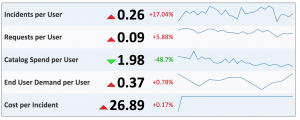Analytics illuminates patterns and behaviors not just by showing information, but by providing context. There are a lot of ways that you can reformat your reports to provide additional context, and in this post we’re going to take a deep look at Year-over-Year reporting.
Year-over-year reporting tries to help you place the current trends in context of trends in previous years. For example, if you’re seeing a spike in incidents, is this a seasonal spike, or specific to this year? Are you on track to have a better or worse year than last year for your KPIs?
